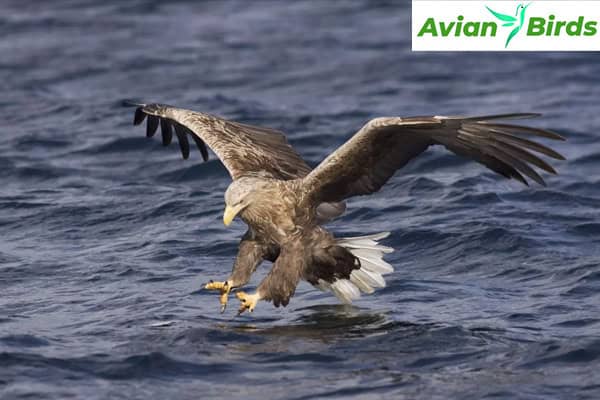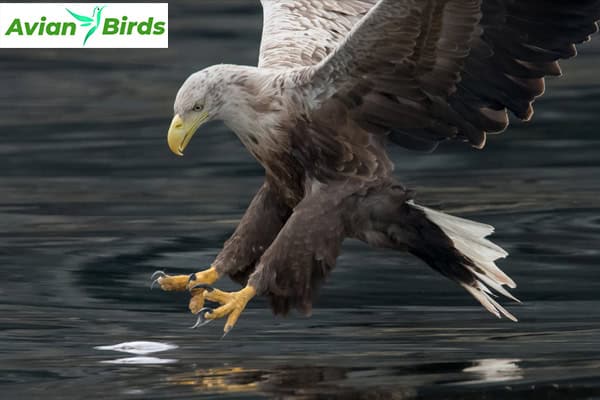Discover the Majestic White-Tailed Sea Eagle
Did you know the White-Tailed Sea Eagle, known as Haliaeetus albicilla, has a wingspan over 8 feet wide? This makes it one of the biggest birds of prey in the world. It’s a stunning sight in the sky. With its royal look and hunting skills, it’s key to the ecosystem in temperate Eurasia.
This article will cover the White-Tailed Sea Eagle from its scientific name to its diet and where it lives. Learning about this bird’s role in nature and why we should protect it will deepen your respect for this iconic raptor.
Here we’ll learn about the White-Tailed Sea Eagle
Quick Fun Facts:
- Scientific Name: Haliaeetus albicilla
- Weight: 4.02 kg (8.9 lb) to 5.11 kg (11.3 lb)
- Length: 66 to 94 cm (26 to 37 inches)
- Wingspan: 1.78 to 2.45 m (5 feet 10 inches to 8 feet 0 inches)
- Age: 12 years
- Diet: Fish, birds, mammals, and other prey
- Family: Accipitridae
What is the White-Tailed Sea Eagle?
This Eagle scientifically known as Haliaeetus albicilla, is a stunning bird in the eagle family Accipitridae. It’s known for its large wings and unique look. Knowing about its scientific classification helps us understand its importance in nature.
Scientific Classification
The White-Tailed Sea Eagle is classified in the Accipitridae family, which includes hawks and kites. Here’s a simple breakdown of its classification:
| Taxonomic Rank | Details |
|---|---|
| Kingdom | Animalia |
| Phylum | Chordata |
| Class | Aves |
| Order | Accipitriformes |
| Family | Accipitridae |
| Genus | Haliaeetus |
| Species | Haliaeetus albicilla |
Physical Characteristics
This Eagle has amazing features. Adults weigh between 4.02 kg (8.9 lb) and 5.11 kg (11.3 lb) and are 66 to 94 cm (26 to 37 inches) long. They have a huge wingspan of 2.45 m (8 ft).

Their feathers are dark, but their tail and head are white, making them stand out. Young eagles take eight years to get their adult look, showing off brown feathers during their growth.
Identifying the White-Tailed Sea Eagle
Learning about the White-Tailed Sea Eagle’s look can deepen your respect for this bird. It’s key to know their size and unique traits that make them stand out.
Size and Appearance
The White-Tailed Sea Eagle has a strong body and wide wings. Its flight looks like a “flying barn door,” showing off its six to eight-foot wingspan. Adults have a pale head and a white tail, which stands out against their dark body feathers. These features help identify them from afar.
Juvenile vs. Adult Differences
Telling a young White-Tailed Sea Eagle from an adult is important for bird lovers. Young eagles have brown feathers with white streaks on their tail. This helps them blend in while they grow up. Females are often bigger than males by about 15%, showing the species’ sexual differences. Knowing these differences makes birdwatching more interesting and helps you understand their life stages better.
Distribution and Habitat
The white-tailed sea eagle lives in many places across Europe. They are mostly found in the north and center of the continent. Some move south for the winter, but others stay in one place all year.

Geographical Range
These eagles love living near the sea, big rivers, and wetlands. These places give them lots of food. Seeing them in different areas shows how well they adapt. Here are some places where you can find them:
- Russia
- Scandinavia
- Central European countries
Preferred Habitats
They pick places with lots of food and good spots to nest. Their ideal homes have:
- Close to water like oceans and rivers
- Nesting spots in tall trees, cliffs, and high places
- Some even nest near busy shipping routes, showing their cleverness
This lets them live in many different places. Being able to choose where to nest is key to their success.
| Region | Characteristics | Common Nesting Sites |
|---|---|---|
| Russia | Large forests and water areas | Tall trees and cliffs |
| Scandinavia | Coastal areas with abundant fish | Cliffs and high vantage points |
| Central Europe | Diverse landscapes with rivers | Tall trees and man-made structures |
Diet and Foraging Behavior
The White-Tailed Sea Eagle is a fish-eater, mainly eating different fish species. It has amazing hunting skills, spotting prey from high up. Besides fish, it eats birds and small mammals, often going for the weak or hurt ones.
Primary Food Sources
Watching the White-Tailed Sea Eagle, you’ll see it focus on certain prey. Pike is a top choice because they live in the same areas and are easy to catch. These eagles also hunt other birds and small mammals, showing how flexible they are in finding food.
Hunting Techniques
This Eagle has special hunting ways that make it stand out. Instead of diving deep, it does shallow dives to catch fish right under the surface. From high spots, it looks for movement in the water before making a quick move. This method helps it catch prey and shows how adaptable it is as a hunter.
Check our Previous Articles:
Frequently Asked Questions:
Q1. What is a sea eagle called?
A sea eagle is often called a sea eagle or fish eagle.
Q2. How big is a white-tailed sea eagle?
The white-tailed sea eagle has a wingspan of about 6 to 8 feet (1.8 to 2.4 meters) and can weigh between 6.5 to 14 pounds (3 to 6.5 kg).
Q3. Are there white-tailed eagles in the US?
No, white-tailed sea eagles are native to Europe and Asia and are not found in the US.







